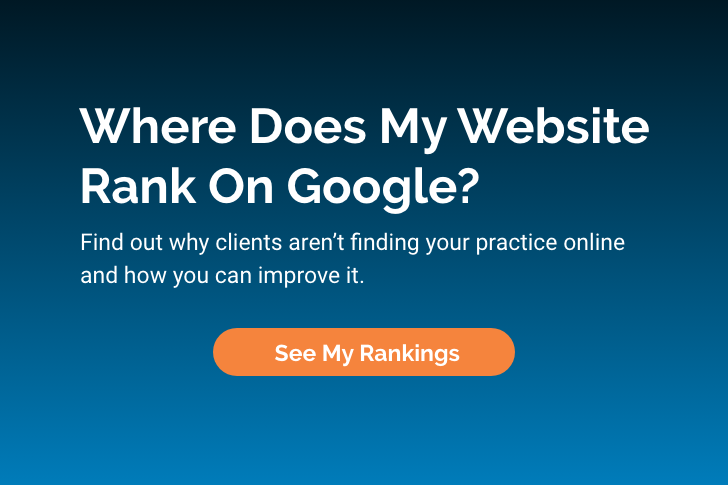Your Guide To Getting To Page 1 Of Google

The Need-To-Knows of Search
Even if you get most of your patients through word of mouth or referrals, getting on the front
page of search engines should be a priority for your practice. Search Engine Optimization (SEO)
is key to getting found by local patients and helping your website rank higher in search results to
increase your online visibility. Our free guide is here to help you learn the ins and outs of getting
to the top of Google.
Here’s what you need to know about search engines, and how to start climbing toward the first page:
8.5 BILLION
Google processes ~ 8.5
billion searches every day
-Internet Live Stats, 2022
1 Billion Searches A Day
Google receives more
than 1 billion health-related searches a day,
averaging 70,000 searches
per minute.
-Medium, 2020
90%
90% of users say they were likely to click on the front
set of results.
-Search Engine Land, 2018
Two ways to better rankings:
1: SEM (Search Engine Marketing)
SEM immediately places an ad for your practice on the front page of Google. You set a monthly
budget, and pay Google a small amount every time someone clicks on your ad. For this reason,
SEM is often referred to as PPC, or pay-per-click advertising. It receives fewer clicks than the
organic search results, but works instantly.
2: SEO (Search Engine Optimization)
SEO refers to a collection of strategies and techniques that aim to help a website earn a higher
placement in the organic section of search results. It can be difficult to earn good results, and the
process takes a long time, but first-page SEO is incredibly valuable.
Top 4 SEO Strategies
1: A mobile-friendly and secure website
Google will penalize your site if it doesn’t
have at least these two capabilities. We
recommend responsive design so that your
website will display perfectly on phones and
tablets. Also, be sure that your site uses HTTPS
security, or Google will tell potential visitors
that it’s unsecure.
2: Content
Content refers to all the information on
your site. If Google determines it’s fresh and
relevant, you will rank higher than other sites.
Prioritize your content for the best results,
especially in areas like:
• Home page
• Patient education
• Pictures and videos
• Blog entries
3: Backlinks/citations
When another website includes a link to your
website, this is called a backlink, or a citation.
Earn links from relevant and respected
websites, and Google will rank your site
higher than those with no links.
#4: Meta title (title tags)
Optional code in the section of your website’s HTML which tells Google “this is what I’m about!” Optimize it for common search terms like your location and specialties.
Top 6 SEM Strategies
1: Negative Keywords
Allows you to exclude words you do NOT want to be found for, e,g, “free,” “budget,” “malpractice”.
2: Configure Extensions
Make your PPC ads more prominent, more informative, and more functional. Add a phone call button, location information, etc.
3: Link to Specific Subpages
Don’t use your homepage as a destination URL. Instead, use a specific subpage so you can determine which patients reached your website through a PPC ad.
4: Be Specific
Highlight specific services you want to be found for, e,g, “pediatric doctor” instead of “doctor.” Specificity raises relevance, which raises search engine ranking, which raises ROI.
5: Use Multiple Ads Per Adgroup
An “adgroup” is the idea or service you’re trying to rank for. Creating different ads with slight differences within each adgroup will allow you to determine which perform well, and which aren’t worth paying for.
6: Use a Schedule
You can adjust when your ads will display within Google Ads. This will allow you to stretch your PPC budget over a greater period of time. Ramp up during slow periods, and remove advertising on days when your practice is closed.
RELATED POSTS
Tags:
Related Posts
- 10 Step SEO Checklist for Therapy Practices ( February 28, 2024 )
- 5 Proven Ways A Tailored Therapist Website Can Grow Your Practice ( January 25, 2024 )
- Navigating The Client Journey: How Online Listings & Reviews Influence Decisions ( October 9, 2023 )
- Unlock Your Practice’s Full Potential With Digital Marketing ( September 8, 2023 )
- How to Utilize Social Media to Grow Your Therapy Practice ( May 15, 2023 )
- Secure More Clients With These 8 SEO Tips ( April 12, 2023 )
- 5 Proven Ways A Custom Therapist Website Attracts More Clients ( January 31, 2023 )
- Stay HIPAA Compliant While Marketing Your Practice ( January 27, 2020 )
- Supercharge Your Online Marketing in 2020 ( December 27, 2019 )
- How to Maximize Your SEO Results ( October 31, 2019 )
Recent Posts
- 7 Blog Post Ideas for Therapists & Mental Health Professionals
- 10 Step SEO Checklist for Therapy Practices
- 5 Proven Ways A Tailored Therapist Website Can Grow Your Practice
- Navigating The Client Journey: How Online Listings & Reviews Influence Decisions
- Unlock Your Practice’s Full Potential With Digital Marketing
- Your Guide To Getting To Page 1 Of Google
- How to Utilize Social Media to Grow Your Therapy Practice
- Secure More Clients With These 8 SEO Tips
- 5 Proven Ways A Custom Therapist Website Attracts More Clients
- 4 Solutions to Help your Practice Online




